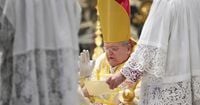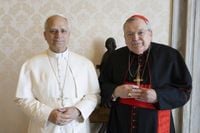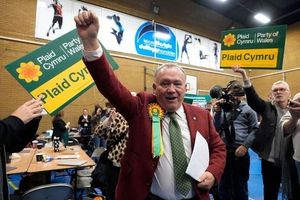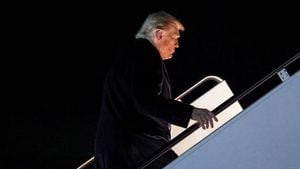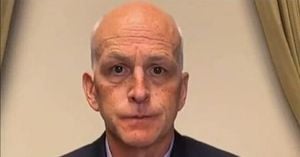On Saturday, October 25, 2025, the cavernous interior of St. Peter’s Basilica was filled with the haunting melodies of Gregorian chant, the scent of incense, and the quiet anticipation of thousands of pilgrims. At the heart of this extraordinary gathering stood American Cardinal Raymond Burke, presiding over a traditional Latin Mass at the Altar of the Chair of St. Peter. This was no ordinary liturgical event: it was the first time in years that the ancient rite—formally known as the Tridentine Mass—had been celebrated in such a prominent Vatican location, and it happened with the explicit blessing of Pope Leo XIV.
For many in attendance, including young families with children and women donning lace veils, the Mass was more than a religious observance. It was a symbol of hope, a tangible sign that the new pontiff might be more sympathetic to their cause than his predecessor. As reported by the Associated Press, Rubén Peretó Rivas, an Argentine organizer of the annual pilgrimage, expressed optimism about the new papacy: “The first signs of Pope Leo are those of dialogue and listening, truly listening to everyone.”
This moment did not arrive without considerable struggle. Under Pope Francis, who in 2021 issued the motu proprio Traditionis Custodes, the celebration of the pre-Vatican II Mass was sharply curtailed. Francis’ decision, he explained, was in response to a Vatican survey of bishops and the advice of the doctrine office, claiming that the old liturgy had become a source of division and was being exploited by those opposed to the reforms of the Second Vatican Council. The restrictions limited the Latin Mass in St. Peter’s Basilica to the tiny Clementine Chapel—seating just eight—and required priests to secure special permissions, effectively sidelining the ancient rite from the Church’s most visible stage.
The annual pilgrimage of Latin Mass devotees, which draws faithful from around the world, found itself unable to secure papal permission for the celebration in either 2023 or 2024. According to Christian Marquant, a French organizer, no one was even willing to approach Francis to make the request. The sense of abandonment ran deep. “We are orphans,” Marquant told the Associated Press, capturing the frustration of many traditionalists who felt their spiritual home had been taken from them.
But the election of Pope Leo XIV in May 2025, the first American to hold the papacy, seemed to offer a new beginning. Leo was elected with a broad consensus among cardinals and announced his intention to foster unity and reconciliation within a Church often riven by liturgical and ideological divisions. Shortly after his election, Marquant and a coalition of about 70 traditionalist groups wrote to Leo, requesting permission for the pilgrimage’s Mass in St. Peter’s. Cardinal Burke, who had an audience with Leo on August 22, personally delivered the letter. The response was affirmative. For the first time since the restrictions, the traditional Latin Mass would return to the basilica’s main altar space, accommodating the expected crowd of over a thousand registered pilgrims and many more who filled the standing-room-only sections.
The significance of this gesture was not lost on the faithful. The old Latin Mass, or Tridentine Rite, dates back to 1570, when it was promulgated after the Council of Trent in an effort to standardize Catholic worship. For nearly four centuries, it was the familiar liturgy for Roman Catholics worldwide. But the Second Vatican Council in the 1960s brought sweeping changes: Mass was translated into local languages, the priest faced the people, and lay participation increased. While these reforms were widely embraced, a segment of Catholics continued to feel a deep attachment to the old rite, drawn by its perceived reverence and beauty.
Efforts to accommodate these traditionalists have been a recurring theme in recent Church history. Pope John Paul II permitted limited celebrations of the Tridentine Mass, and Pope Benedict XVI’s 2007 Summorum Pontificum removed the need for local bishop approval, sparking a modest revival, especially among younger Catholics. Benedict envisioned the old and new rites as two forms of the same liturgy, writing, “These two expressions of the Church’s lex orandi [rule of prayer] will in no way lead to a division in the Church’s lex credendi (rule of faith); for they are two usages of the one Roman rite.”
However, Francis’ 2021 restrictions reversed much of this openness. Cardinal Burke, a prominent critic of the move, described Traditionis Custodes as “severe and revolutionary” and called for the Vatican to release the full results of the bishops’ survey. In a 2025 interview, Burke emphasized the enduring spiritual value of the old rite: “You cannot take something that is so rich in beauty and remove the beautiful elements without there being negative effects.”
The debate intensified in July 2025 when leaked Vatican documents suggested that the majority of bishops who responded to the Vatican’s survey were actually satisfied with the old Latin Mass and cautioned that stricter regulations would “do more harm than good.” This revelation appeared to contradict Francis’ rationale for the crackdown. Vatican spokesman Matteo Bruni did not confirm the documents’ authenticity but acknowledged they were likely part of the decision-making process, albeit incomplete.
Pope Leo XIV, for his part, has signaled a desire for dialogue and a possible “middle way.” In an interview with his biographer, Elise Allen, Leo admitted, “Between the Tridentine Mass and the Vatican II Mass, the Mass of Paul VI, I’m not sure where that’s going to go. It’s obviously very complicated.” He lamented the liturgy’s role as a political tool and the polarization it has caused, adding, “That’s a problem in itself. It means we’re into ideology now, we’re no longer into the experience of church communion.” Leo has hinted that a solution might involve greater reverence and traditional elements within the ordinary form of the Mass, rather than a wholesale return to the past.
For Catholics like James Rodio, a Cleveland psychiatrist and father of three who has attended the traditional Latin Mass for decades, the recent developments inspire cautious optimism. “Behind it all, there was a sadness and sense that Francis didn’t understand them,” Rodio told the Associated Press. But with Leo’s apparent openness, he and his fellow parishioners are hopeful. The Diocese of Cleveland, for example, recently received a two-year extension to continue Latin Masses at two churches. “My guess is Leo may try to do a lot by not doing a lot publicly,” Rodio mused, reflecting the hope that the new pope’s approach will be one of quiet accommodation rather than dramatic pronouncements.
In the end, the return of the traditional Latin Mass to St. Peter’s Basilica stands as a powerful symbol of the Catholic Church’s ongoing struggle to balance tradition and change, unity and diversity. Whether this marks the beginning of a new era for the old rite, or simply a brief respite, remains to be seen. But for one Saturday in October, the ancient prayers echoed once again beneath Michelangelo’s dome, and for many, that was miracle enough.
